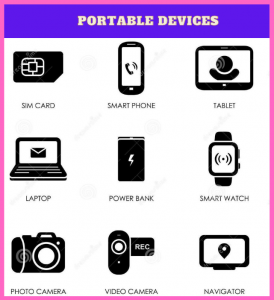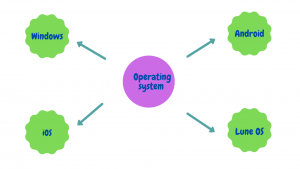Portable devices
What are portable devices?
A portable computer is easy to carry. It is a compact computing system form factor built to transport and be used for the hand. Portable computers have become an extremely important aspect of human computing, as computers such as laptops, tablets, and smartphones start to progress their capabilities. A handheld computer or mobile computer may also be considered a portable unit. Portable devices are mainly battery-powered devices with basic computing benefits in the field of a CPU, memory, storage, and access to the internet. Extremely lightweight are the newest portable devices, making them more likely to carry and keep. That isn’t the case with previous attempts at portable computers. It also is possible to find portable computers, tiny plug-and-play computers including such USB drives, removable hard disks, and video cameras.

Figure 1. Portable devices
The invention of a small Microprocessor.
The last two decades are seeing a technology developed that has fundamentally transformed the way we view and monitor the environment surrounding. Born of concurrent advances in computer engineering and embedded circuit manufacturing, the microprocessor, or “machine on a chip,” became a better business in 1971 when a minor, unidentified organization called Intel Corporation launched the 4-bit 4004. Processors designed specifically for portable computers provide lower demands on energy usage and generate less radiation than traditional processors. We may modify the processor on certain communication devices to just use a smaller bus speed while operating from battery capacity, thus saving the battery capacity. Most motherboard chipsets are able to automated routing to shut off additional cores or lower the frequency for energy conservation. Processors don’t have the broad variations of heat sinks and fans for heat dissipation. Heat is regulated by reducing energy consumption and the heat-removing tiny fans.
The Applications of portable devices.
The embedded system uses a microprocessor to only perform one operation and one operation. There is only one device program normally loaded into ROM. House-Appliances, loudspeaker, cell phones, surveillance systems, door locks, digital assistants, rotary phones, personal computers, Television, cable Television tuner, Cassette player, video camera, a navigation system, playing games, mobile devices, sports equipment, machine tools, smart lighting, file system, camera, pool tables, toys, exercise machines are the places where the micro controller is present. Business – cellular phones, printers, surveillance devices, photocopiers, convection microwave, coffee machine, scanner printers, color projector, automobile scrolling Trip monitor, hydraulic pumps, airbag, ABS, modulation, warning system, application layer, television, air conditioning, cellular telephones, central locking.
Which kind of operating system a portable device uses?
The operating system of gadgets such as Ipad and smartphones addresses several technical issues with the passing of time. These handheld devices have become increasingly high strength and high-performance so that their OS has become increasingly complex to build. As we’ve seen from this study, many mobile device vendors give greater attention to their OS as if their entire software is badly built, no matter how successful the technology is, this can alter the consumer opinion of the app overall. Unless the computer loses its internet connection each second or hangs or causes potential issues, then the operating system will not be properly designed and checked under various scenarios and conditions after installation on the computer. As stated in this article, the greatest example of a very well-designed OS in the smartphone world is Android, windows mobile, ios, etc.

Figure 2. Portable devices OS
The design of a portable device.
Portable devices are designed to be more lightweight and easier to hold. Components are connected closer to each other and are designed to reduce power consumption since portable computers mostly operate on battery capacity. As the devices are designed to be shipped around, they must, therefore, endure further wear – and – tear. cell membrane smartphone makers have always been at the forefront of the development standards for data transmission through the applicable networks. The GSM network was especially responsible for leading standards in fast communication over communications phones. Transmission of data over GSM unfolded at 9600 bps in the early 1990s. The launch of packet radio Services or GPRS (which operates over non-modified GSM networks) culminated in data speeds rising between about 56 and 114 kbps. GPRS has also provided continuous communication for customers. GPRS is a packet-based service, which ensures that the number of packets is only sent as needed, and this will, in principle, result in decreased communication costs because multiple members can access the network spectrum in a region at a certain time. Compare that with the connection-based paradigm of the current GSM data access, which implied that additional bandwidth was assigned to users. Either the video controller is built into the motherboard or a separate board may be removed. While some devices have specific video memory, video memory usually shares a majority of the device memory. Many devices have an external video port for viewing the image on a screen or console.
The future of portable devices.
The internet currently features a 4 G network. This network allows for fast data transfer in the networks, making Internet browsing simpler. Smartphones should be aware of their surroundings in the future, these will be able to make use of the resources such as physical internal detectors and the simplicity in which data is shared. One way to accomplish this phenomenon is that electronic devices will start to keep a record of the customer’s personal records, but they’ll be able to anticipate user preferences on what they want to use or even the details they are interested in accessing almost accurately. It can be accomplished by determining track of easier activities for the customer. Smartphones will be fitted with the X-Ray system during the next evolution of cellular devices, which will be able to detect accurate details about the direction to which the phone is directed at that specific moment. Various companies are currently creating applications that would be able to reliably detect the phone or user’s precise address or present position. Another product called Omni touch falls together with the field of digital computing, this is a tool that allows for application to be used on the side, neck, desk, walls and just about every other simple substrate. The app has a fingerprint scanner interface that allows the consumer to connect by using the touch of the fingers. This has benefited humanity in several ways since before the advent of the smartphone; and some of those are: cell phones are quite useful in the case of emergency these are good to enter in accidents involving as well as other associated conditions. Some of the most critical uses of smartphones are to guarantee protection. Family members can connect easily while abroad. Mobile technology will be here to live to top it and has a lot many apps in the process to achieve only the most common requirements and create life much simpler.